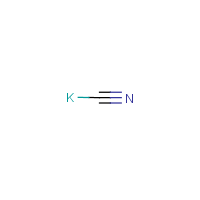Potassium cyanide
Agent Name
Potassium cyanide
CAS Number
151-50-8
Formula
C-K-N
Major Category
Toxic Gases & Vapors

Synonyms
Cyanide of potassium; Cyanure de potassium [French]; Hydrocyanic acid, potassium salt; Kalium cyanid [German]; M-44 capsules (potassium cyanide); Potassium cyanide; Potassium cyanide (K(CN)); [ChemIDplus] UN1680
Category
Cyanides
Description
White, granular or crystalline solid with a faint, almond-like odor; [NIOSH] Deliquescent; [CHEMINFO]
Sources/Uses
Used mainly for silver plating; Also used in steel hardening, gold and silver extraction, and fumigation (fruit trees, ships, railroad cars, and warehouses); [HSDB] Used in photography (reducer); [www.ci.tucson.az.us/arthazards/medium.html]
Comments
There are two common scenarios for cyanide poisoning in the industrial setting: 1) mixing acid and cyanide solutions, and 2) pouring cyanide wastes into non-alkaline solutions. Mixing cyanide salts with water, e.g., showering in clothes contaminated with cyanides, will generate hydrogen cyanide gas. Dermal absorption of cyanide salts deposited on large areas of skin can result in fatal poisoning. [Sullivan, p. 705-6] The moist solid form is caustic to skin. [CHRIS] A severe skin, eye, and respiratory tract irritant; [ICSC] "The substance may cause effects on the cellular respiration, resulting in convulsions and unconsciousness; The substance may have effects on the thyroid"; [ICSC]
Restricted
"This chemical ingredient is not found in any products." [National Pesticide Information Retrieval System]
Biomedical References
Exposure Assessment
Skin Designation (ACGIH)
Yes
TIH
Yes
Dangerous When Wet
Yes
Ceiling (ACGIH)
5 mg/m3, as CN
PEL (OSHA)
5 mg/m3, as CN
MAK
5 mg/m3, as CN, inhalable fraction
IDLH (NIOSH)
25 mg/m3, as CN
Excerpts from Documentation for IDLHs
Human data: Absorption of the alkali cyanides in amounts as low as 50 to 100 mg from a single, instantaneous dose may be followed by immediate collapse and cessation of respiration [Clayton and Clayton 1982]. It has been stated that although the fatal oral dose will vary considerably, depending on whether or not food is present in the stomach, it is probably in the order of 1 to 2 mg/kg [Clayton and Clayton]. [Note: An oral dose of 50 to 100 mg or 1 to 2 mg/kg is equivalent to a 70kg worker being exposed to about 50 mg/m3 (as CN) for 30 minutes, assuming a breathing rate of 50 liters per minute and 100% absorption.]
Explanatory Notes
For TLV, see "Hydrogen cyanide." Not TIH in land-based spills, but TiH substance released when spilled in water; [ERG 2016]
Reference Link #2
NFPA
will not burn
Adverse Effects
Dermatotoxin
Skin burns
Other Poison
Chemical Asphyxiant
Diseases, Processes, and Activities Linked to This Agent
Diseases
Occupational diseases associated with exposure to this agent:
Processes
Industrial Processes with risk of exposure: